Stanley Fischer: Is there a liquidity problem post-crisis?
Speech by Mr Stanley Fischer, Vice Chair of the Board of Governors of the Federal Reserve System, at the "Do We Have a Liquidity Problem Post-Crisis?", a conference sponsored by the Initiative on Business and Public Policy at the Brookings Institution, Washington DC, 15 November 2016.
The views expressed in this speech are those of the speaker and not the view of the BIS.
Market liquidity is the ability to rapidly execute sizable securities transactions at a low cost and with a limited price impact.1 The high degree of liquidity in U.S. capital markets historically has contributed to the efficient allocation of capital through lower costs and a mix of bank- and market-based finance that supports the flexibility of these markets.2 Regulatory changes may have altered financial institutions' incentive to provide liquidity, raising concerns brought into sharp relief by several "flash events" over the past few years. At the same time, any changes in observed liquidity are also likely accompanied by other related changes-such as in technology-and a more complete assessment of these shifts is important when we think about the effects on liquidity of changes in financial regulations that were induced by the global financial crisis.3
This afternoon, I will first review some of the concerns raised by market participants and others about market liquidity as well as highlight the challenges associated with finding clear evidence that substantiates these concerns. I will then discuss whether potential impairment of liquidity might exacerbate problems related to fire sales and leverage. Finally, I will make the case that any changes in market liquidity resulting from regulatory changes should be analyzed in the broader context of the overall safety of the financial system. This perspective naturally emphasizes potential tradeoffs between the possibly adverse effect regulations may have on market liquidity and their positive effect on the stability of the financial system.
Market Participants' Concerns
1. Decline in dealers' inventory
Market participants have cited a decline in dealers' inventories as a possible source of decreased liquidity. Figure 1 shows that primary dealers' inventories of fixed-income securities, which are predominantly used for market making, declined sharply after the Lehman Brothers failure, from about $1.3 trillion to about $800 billion, and have since fallen further to about $700 billion. The recent decline might be due in part to regulations, such as the Volcker rule and the Supplementary Leverage Ratio, aimed at making the financial system safer and sounder, as well as to changes firms may have made on their own, perhaps in reaction to the experience of the financial crisis. Regardless of the causes of the change, market participants have expressed a concern that the decline in inventories reflects in part a reduced willingness or capacity of the primary dealers to make markets-which may in turn lead to lower liquidity. However, whether markets are in fact less liquid depends on both the degree to which the decrease in primary dealers' inventories affects their willingness to provide liquidity and the extent to which nonbank firms such as hedge funds and insurance companies fill any lost market-making capacity.4
2. Decline in trade size and turnover
Market participants also often cite the decline in average trade size and turnover-the volume of trades relative to the total amount of bonds outstanding-as evidence of reduced liquidity. Figure 2 shows that average trade size in the corporate bond market has indeed declined since 2006 but has been relatively stable in the past four years. Nevertheless, this decrease may reflect a number of factors, including changes in technology or the types and preferences of institutions engaged in trades, so it may not indicate a reduction in market liquidity. Certainly, the length of this trend, roughly a decade, seems on its face more consistent with a secular trend such as technological change. Turnover in the corporate bond market has declined as well, though this evidence is also not a definitive sign of reduced market liquidity. The decline in turnover is not driven by a reduction in trading volume, but it is the result of a robust growth of the denominator, debt outstanding.
3. Liquidity during times of stress
Market participants further express concern about the potential for market liquidity to become less resilient during times of stress, when it is needed the most. However, evidence on this front is difficult to gather. Some argue that market liquidity is resilient because financial markets appear to have functioned fairly well during recent episodes of high market volatility, such as following the Brexit vote or earlier this year, when oil prices were low and stock market volatility was high. Others argue that it is not. According to a recent study, the cost of trading distressed corporate bonds appears to be higher now than in the recent past.5 Specifically, the authors find that, before the crisis, the cost of a $1 million bond transaction increased about 0.7 percent following a downgrade, but-after the Volcker rule-the cost following a downgrade rose 2.4 percent. This analysis, however, is limited to episodes of distressed borrowers rather than a systemwide stress.
4. Flash events
In addition, recent flash events-such as the sharp movement in Treasury prices on October 15, 2014; the rapid rise and decline of the euro-dollar exchange rate on March 18, 2015;6 and the swing in sterling on October 7, 2016-have led some to assert that market liquidity has become less resilient. Researchers at the Federal Reserve Bank of New York have argued that spikes in volatility and sudden declines in liquidity have become more frequent in both Treasury and equity markets.7 The Commodity Futures Trading Commission also points out that flash events are more common now.8 Market participants suggest that the rapid growth in high-frequency trading in equity, foreign exchange, and U.S. Treasury markets, along with broader concerns about less resilient liquidity, potentially explains these flash events. Nevertheless, a report on the October 15, 2014 event by the staff of the Treasury Department, Federal Reserve, and market regulatory agencies found no single factor that caused the sharp swing in prices.9
A Broader Review of the Evidence
1. Trading costs are low
Even though flash events appear to be more common, it is certainly too soon to declare that a broad reduction in market liquidity has occurred. Figure 3 plots realized bid-ask spreads for investment-grade corporate bonds over time (the black dashed line) and speculative-grade corporate bonds (the red solid line). Prior to the financial crisis, the cost of trading corporate bonds was low-on average, bid-ask spreads were about 1 percent of the price of the bond for investment-grade bonds and about 2 percent for speculative-grade bonds. This measure of trading costs skyrocketed during the financial crisis but has returned to the range seen in the few years prior to the crisis. Alternative measures of trading costs, such as price impact measures, which attempt to capture the effect of transactions on market prices, follow a similar pattern.
Transaction costs seem to suggest liquidity has improved. One caveat, however, is that measures of aggregate transaction costs in the corporate bond market may underestimate embedded liquidity costs. In preliminary work, Choi and Huh suggest that transactions in which dealers act simply as brokers, rather than as intermediaries that hold assets on their balance sheets, could reflect price concessions that dealers make to entice counterparties into the other side of a trade so that the dealers will not need to hold the traded assets.10 Price concessions, in turn, lower traditional measures of trading costs, making trading seem inexpensive, when in reality these concessions are fees the dealers pay to some investors for providing liquidity. Moreover, as dealer inventories have declined over the past few years, this downward distortion to aggregate trading cost measures may have increased. To address this problem, Choi and Huh try to isolate transactions in which corporate bond investors are looking for liquidity (in other words, are looking to trade) and then construct measures of transaction costs for only such trades. The paper's results are preliminary but appear to suggest transaction costs have increased somewhat in recent years.
2. Trading volume is high
Another commonly used measure of liquidity is trading volume. Figure 4 shows trading volume in the corporate bond market. This measure is important because low trading volumes may indicate that high transaction costs have deterred investors from making trades, a phenomenon that transaction cost measures would clearly miss because they are calculated from actual trades. The trading volumes depicted in the figure show no obvious signs of a current problem with market liquidity. In 2006, investors traded an average of $12 billion a day. During the height of the financial crisis, trading volume decreased to $8 billion a day, but, by 2009, volumes appeared to have fully recovered. Today trading volumes are at about $19 billion a day. On balance, the evidence presented in these two figures seems to suggest that market liquidity has not deteriorated in recent years-subject, of course, to the caveat I just discussed about the possibility that our measures of bid-ask spreads could be distorted by the increasing role of investors as suppliers rather than demanders of liquidity.11
As an aside, the market liquidity figures shown are only for the corporate bond market, but we see similar patterns in the equity and Treasury markets.12 That is, we do not find convincing evidence that liquidity has markedly declined in those markets.
Policy Issues Related to Market Liquidity
While the evidence for changes in market liquidity does not point clearly to a reduction, I have highlighted some recent research that indicates the possibility that market liquidity has fallen. To date, observed changes in liquidity do not suggest that shifts in liquidity are having a notable effect on the cost of trading. Nonetheless, the potential for liquidity to evaporate in times of stress deserves careful scrutiny-along with broader risks to financial stability associated with changes in markets.
One area where policy concerns have arisen is related to the potential for fire sales in bond markets, which could compound the risks associated with leverage in the financial sector. Bond markets have grown considerably, and market-based finance has intensified over the past years, making market liquidity even more important.13 In addition, mutual funds that offer daily redemption rights hold a greater share of bonds than investors who buy and hold. As shown in figure 5, the share of investment-grade and high-yield corporate bonds held at mutual funds (the solid blue area) has hovered around 25 to 30 percent in recent years, up from about 15 percent before the crisis.
Reduced market liquidity might exacerbate fire sale risks from leverage at financial institutions or from first-mover advantage at mutual funds. Leveraged institutions are more sensitive to changes in asset prices. Adverse movements in asset prices, margin calls, and higher haircuts may force them to sell assets to obtain cash and delever, affecting other market participants through declining asset prices and increased margin calls.
In addition, leverage may closely interact with liquidity risk at mutual funds. Open-end mutual funds are characterized by the so-called first-mover advantage: Investors can redeem daily from the funds that hold assets that are less liquid, while liquidation costs are borne by investors remaining in the fund. If a decline in bond prices leads to sizable fund withdrawals, the first-mover advantage could accelerate redemptions and second-round price declines. In addition, investors may perceive leveraged funds that experience stress as riskier, possibly becoming more inclined to redeem from these funds. This situation could be worse than in the past if market liquidity deteriorates and dealers are less willing to buy and hold bonds in inventory to cushion the price decline induced by fire sales. However, thanks to recent regulation and supervisory changes, including higher capital requirements and stress tests, leverage at the largest intermediaries is much reduced relative to pre-crisis norms-and, as a result, vulnerabilities from potential fire sale risks are less significant. From this perspective, a small reduction in liquidity from regulatory changes-even if present, which is not obvious-may be a reasonable price to pay for greater safety. I will now place changes in liquidity into the broader context of financial stability.
Tradeoff between Liquidity and Regulations to Achieve a Safer Financial System
It is possible that regulations aimed at correcting vulnerabilities in the financial system-like the Supplementary Leverage Ratio, together with other factors-have altered the business model of dealer firms and, thus, liquidity. While the evidence for a reduction in market liquidity is far from clear, let us for the moment accept this possibility and consider the potential effects on financial stability.
Regulatory changes, even those that may have reduced market liquidity, likely have enhanced financial stability on balance. Recent evidence indeed points in favor of enhanced financial stability. Regulatory capital ratios for banks and insurance companies remain high, which, as previously mentioned, would mitigate fire sales and their effect on the solvency and functioning of these institutions. Leverage at intermediaries is much reduced relative to pre-crisis norms, and gross leverage at hedge funds, based on the partial information available, has not changed much in recent years. Research from economists at the Federal Reserve Bank of New York shows that the decline in leverage, among other factors, has substantially reduced potential fire sale externalities in the banking and broker-dealer sectors.14 Thus, the regulatory changes appear to be having a positive effect on financial system stability, and these benefits may outweigh the potential costs of a possible reduction in liquidity.
Regulatory changes are in train for the asset management industry, whose vulnerabilities have been under examination by the Financial Stability Oversight Council and the Financial Stability Board.15 The Securities and Exchange Commission (SEC) has recently approved rules to modernize and enhance the reporting and disclosure of information by registered investment companies and to enhance liquidity risk management by open-end funds, including mutual funds and certain exchange-traded funds.16 The SEC has also proposed rules that would put new limits on registered funds' gross notional derivative exposures, enhance the requirements for asset segregation in derivatives transactions, and include new risk-management requirements for the use of derivatives.17
Conclusion
Overall, liquidity is adequate by most measures, in most markets, and most of the time.18 Bid-ask spreads and price-impact measures point toward liquidity that is good by historical standards, and we have not observed declines in market liquidity in recent episodes of high market volatility. Nevertheless, the market structure is changing, and trades in certain situations and in certain market segments might have become more costly. Also, flash events may be more frequent today, and the dynamics of a system with frequent flash events are likely to become complicated. Moreover, some regulatory changes are only now being phased in. In light of these changes and the evolving structure of financial markets, it will be important to monitor and continue to analyze the state of market liquidity. As we monitor, we should continue to emphasize how the evolution of market liquidity interacts with broader changes to affect the efficient allocation of capital and financial stability. And we should always bear in mind the possibility that new financial developments could change the dynamics of market responses to unanticipated economic developments.
References
Adrian, Tobias, Michael Fleming, Daniel Stackman, and Erik Vogt (2015). "Has Liquidity Risk in the Treasury and Equity Markets Increased?" Federal Reserve Bank of New York, Liberty Street Economics (blog), October 6.
Bao, Jack, Maureen O'Hara, and Xing (Alex) Zhou (2016). "The Volcker Rule and Market-Making in Times of Stress," working paper, September.
Bessembinder, Hendrik, Stacey Jacobsen, William Maxwell, and Kumar Venkataraman (2016). "Capital Commitment and Illiquidity in Corporate Bonds," working paper, July.
Choi, Jaewon, and Yesol Huh (2016). "Customer Liquidity Provision in Corporate Bond Markets," working paper, September.
Duarte, Fernando, and Thomas M. Eisenbach (2013). "Fire-Sale Spillovers and Systemic Risk (PDF)," Federal Reserve Bank of New York Staff Reports 645. New York: Federal Reserve Bank of New York, October (revised February 2015).
Duffie, Darrell (2012). Market Making under the Proposed Volcker Rule (PDF), report to the Securities Industry and Financial Markets Association and submission to the Office of the Comptroller of the Currency, the Board of Governors of the Federal Reserve System, the Federal Deposit Insurance Corporation, and the Securities and Exchange Commission. Stanford, Calif.: Graduate School of Business, Stanford University, January.
Financial Stability Board (2016). Proposed Policy Recommendations to Address Structural Vulnerabilities from Asset Management Activities (PDF), consultative document. Basel, Switzerland: FSB, June.
Financial Stability Oversight Council (2016). Update on Review of Asset Management Products and Activities (PDF). Washington: FSOC, April.
Massad, Timothy (2015). "Remarks of Chairman Timothy Massad before the Conference on the Evolving Structure of the U.S. Treasury Market," speech delivered at the Federal Reserve Bank of New York, New York, October 21.
Powell, Jerome H. (2015). "Structure and Liquidity in Treasury Markets," speech delivered at the Brookings Institution, Washington, August 3.
Trebbi, Francesco, and Kairong Xiao (2015). "Regulation and Market Liquidity," NBER Working Paper Series 21739. Cambridge, Mass.: National Bureau of Economic Research.
U.S. Department of the Treasury, Board of Governors of the Federal Reserve System, Federal Reserve Bank of New York, U.S. Securities and Exchange Commission, and U.S. Commodity Futures Trading Commission (2015). Joint Staff Report: The U.S. Treasury Market on October 15, 2014 (PDF). Washington: Treasury, Board of Governors, FRBNY, SEC, and CFTC, July.
U.S. Securities and Exchange Commission (2015a). "Open-End Fund Liquidity Risk Management Programs; Swing Pricing; Re-Opening of Comment Period for Investment Company Reporting Modernization Release (PDF)," proposed rule and re-opening of comment period, releases 33-9922 and IC-31835, files S7-16-15 and S7-08-15. Washington: SEC, October.
---- (2015b). "Use of Derivatives by Registered Investment Companies and Business Development Companies (PDF)," proposed rule, release IC-31933, file S7-24-15. Washington: SEC, December.
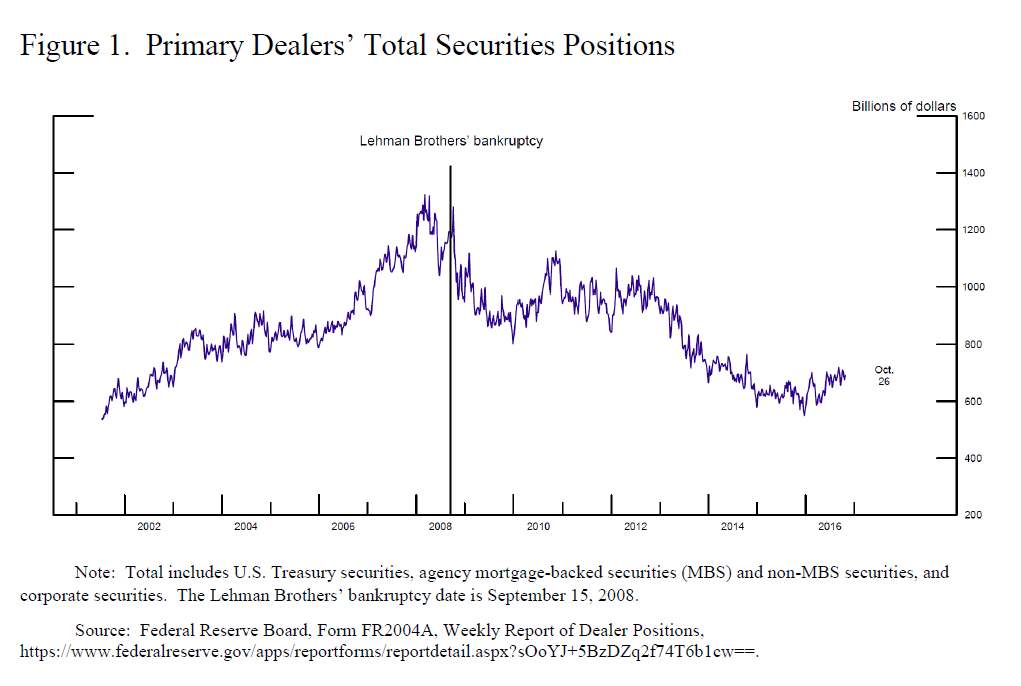
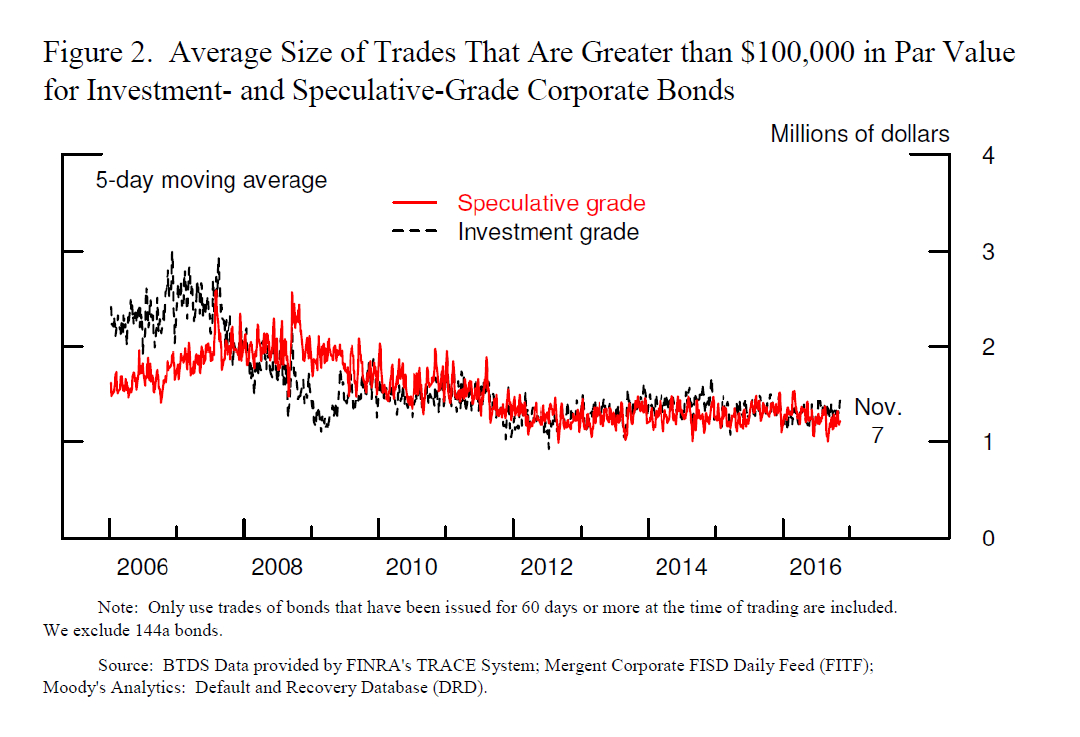
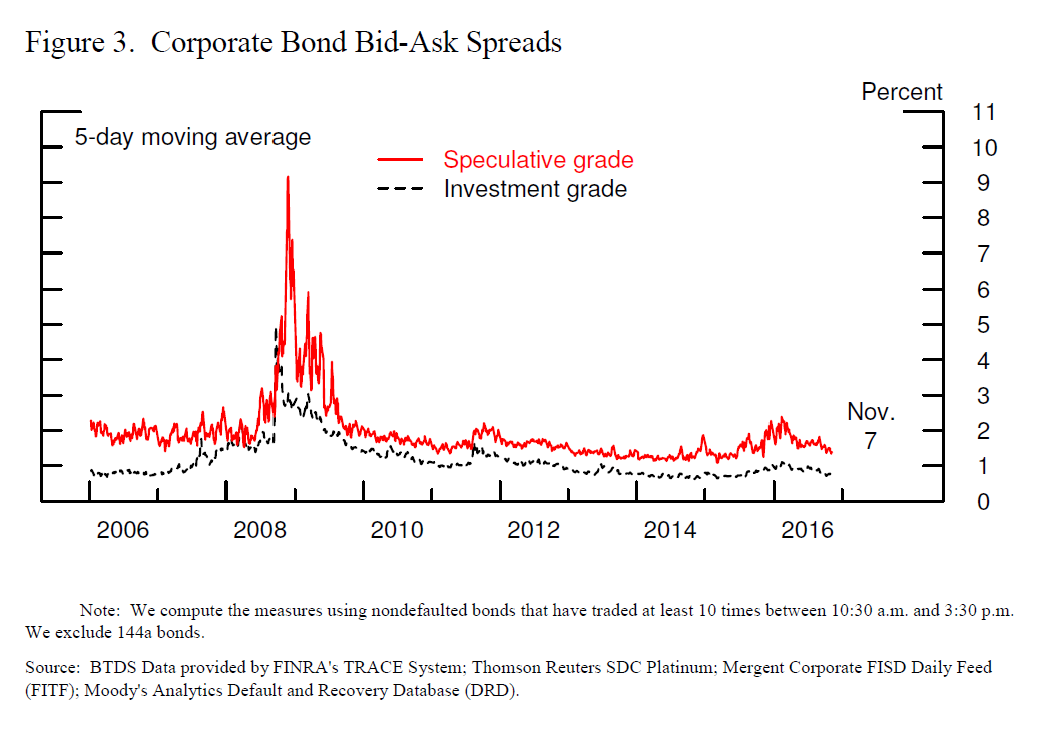
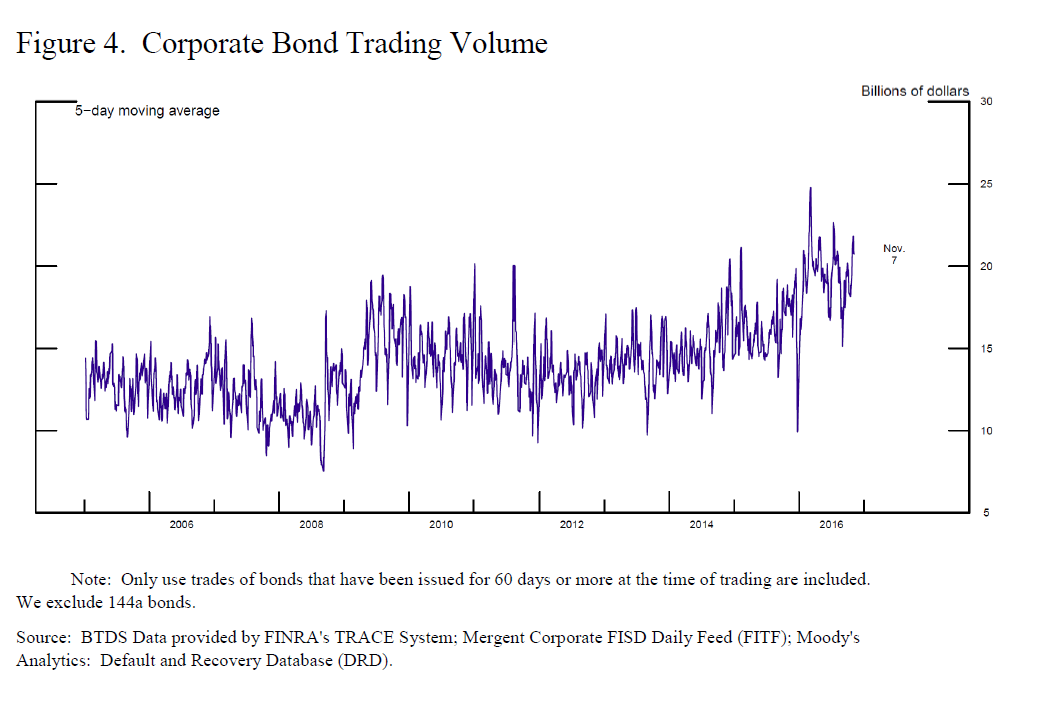
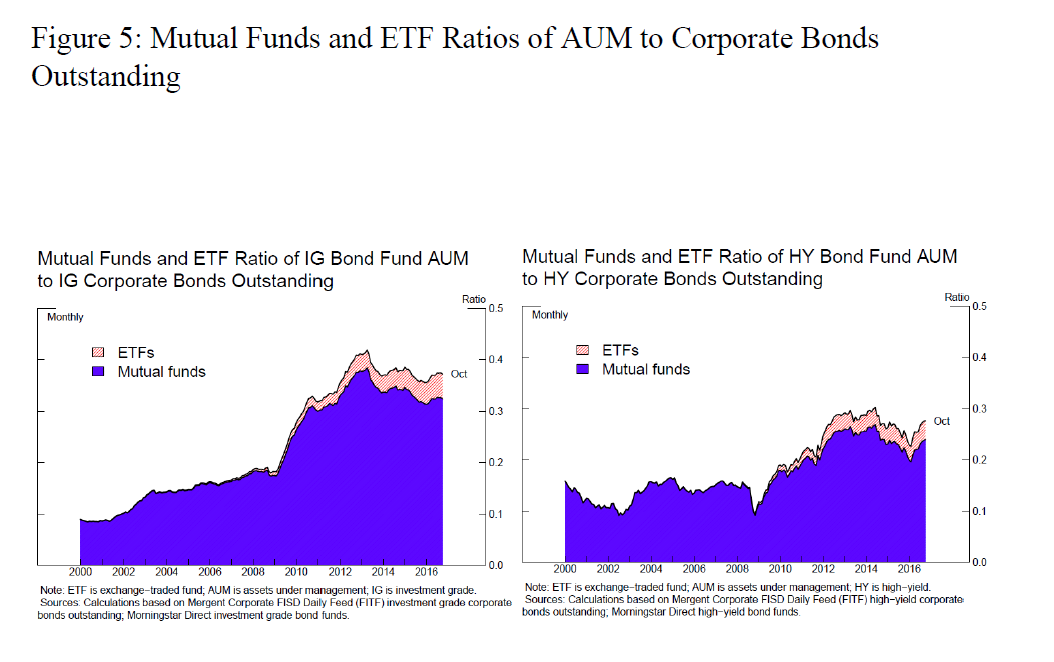
1 This is the definition of market liquidity presented in chapter 2 of the IMF's Global Financial Stability Report, September 2015, p. 50.
2 In this speech, I am discussing market liquidity, not funding liquidity.
3 I am grateful to Chiara Scotti and Clara Vega of the Federal Reserve Board staff for their assistance. Views expressed are mine and are not necessarily those of the Federal Reserve Board or the Federal Open Market Committee.
4 Bessembinder, Jacobsen, Maxwell, and Venkataraman (2016) find that bank dealers are less willing to provide liquidity now than in the recent past, while nonbank dealers are more willing. Duffie (2012) argues that the negative effect the Volcker rule may have on market liquidity in the short run may disappear in the long run as nonbanks step in to provide liquidity. Duffie (2012) also mentions that the migration of liquidity provision from banks to nonbanks, which are not regulated, may have potentially important adverse consequences for financial stability.
5 See Bao, O'Hara, and Zhou (2016).
6 See Powell (2015) for a discussion of recent flash events and other changes in the behavior of bond prices.
7 See Adrian and others (2015).
8 See Massad (2015).
9 See U.S. Treasury and others (2015).
10 See Choi and Huh (2016).
11 Trebbi and Xiao (2015) analyze multiple corporate bond liquidity measures and conclude that there is no evidence of deterioration in liquidity due to regulation.
12 Secured funding spreads have increased, suggesting higher intermediation costs in the repo (repurchase agreement) market.
13 A market-based system is one where securities markets share center stage with banks in allocating capital, in contrast to a bank-based system, where banks play a leading role.
14 See Duarte and Eisenbach (2013).
15 See Financial Stability Oversight Council (2016) and Financial Stability Board (2016).
16 The SEC approved the proposed rule on October 13, 2016. See U.S. Securities and Exchange Commission (2015a).
17 See U.S. Securities and Exchange Commission (2015b).
18 I thank Jerome Powell for this statement.
